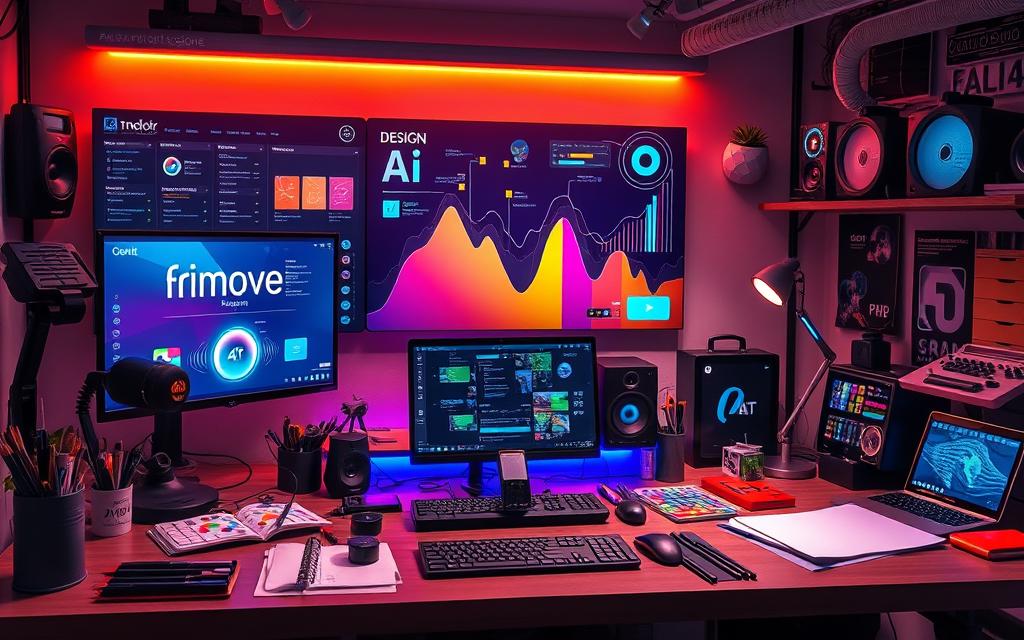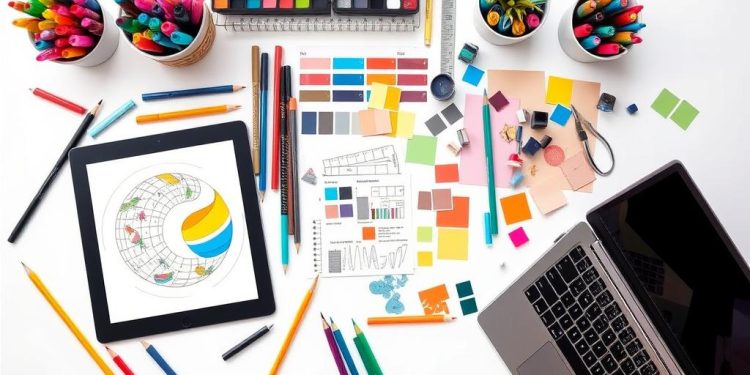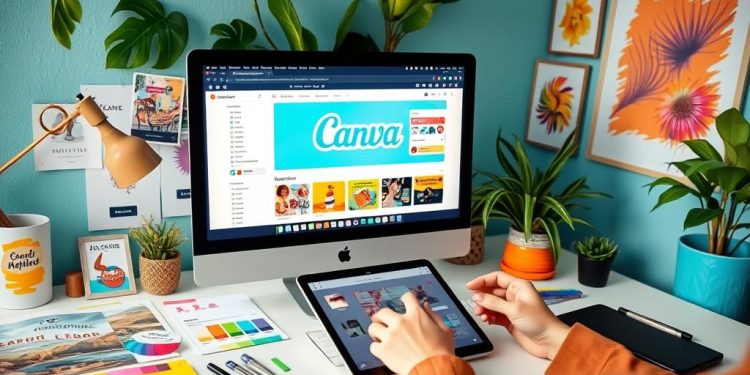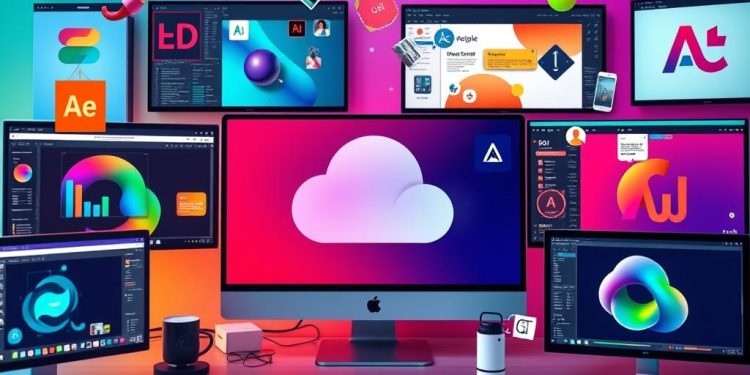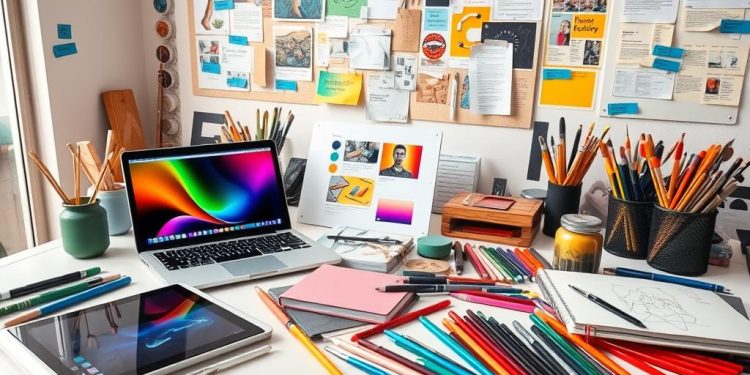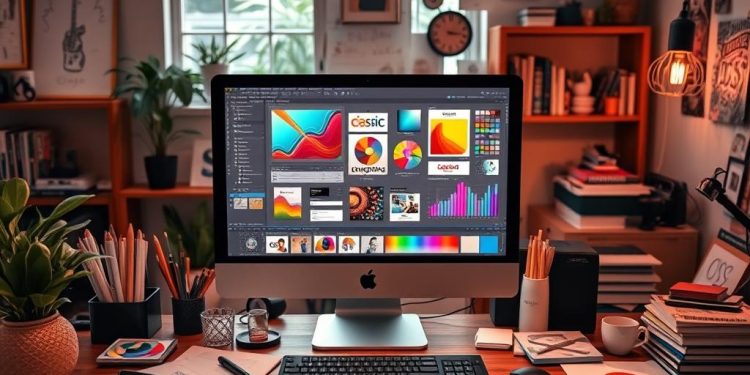The landscape of graphic design is evolving at an unprecedented pace, with emerging technologies and innovative tools transforming the field. As you navigate through the latest graphic design trends, you’ll discover that the integration of AI in design is not just a passing trend; it’s reshaping how designers operate and create impactful visuals. With expectations that AI tools could cut project completion times drastically, graphic designers are on the brink of a revolution in efficiency and creativity.
Moreover, the rise of immersive experiences through technologies like Virtual Reality (VR) is expanding design opportunities. The global market for VR exceeded $21 billion in 2021, highlighting its growing importance beyond just entertainment. As you explore these future tools, consider how they not only enhance user engagement but also align your design work with modern consumer behavior. This article will delve into the transformative effects of these trends, paving the way for a better understanding of what to expect in graphic design.
The Evolution of Graphic Design Tools
Graphic design tools have seen an extraordinary evolution, dramatically enhancing how creative professionals operate. From the early days of print design to the modern realm of digital design, this transformation has been driven by advancements in technology and changing consumer demands.
From Print to Digital: A Brief History
The transition from print to digital design marked a pivotal moment in graphic design evolution. Early design practices relied on physical materials and manual processes, limiting creativity and efficiency. The introduction of software like Adobe Illustrator revolutionized how designers conceptualize and execute projects. As design software grew more sophisticated, the accessibility of these tools increased, allowing more people to engage in design activities.
The Role of Technology in Design Transformation
Advancements in technology have played an essential role in design transformation. Tools powered by artificial intelligence have now become commonplace, enabling design tasks that were once tedious to be automated, increasing productivity by 25% by 2025. With these innovations, designers can focus on more complex elements of their work, such as developing character-driven narratives that forge emotional connections through brand storytelling.
As we look forward, the rise of abstract design styles will correlate significantly with the growth of digital tools and social media. By 2025, 70% of graphic design elements are expected to incorporate some form of animation, showcasing the shift towards dynamic content that enhances user engagement. This trend toward storytelling animation highlights a departure from basic motion graphics to more intricate designs, reflecting a broader graphic design evolution.
AI in Graphic Design: Changing the Game
AI in design is reshaping the landscape of graphic creation by streamlining processes and enhancing creativity. Automation handles tedious tasks, freeing designers to focus on imaginative elements. By reducing time spent on repetitive activities, professionals experience boosts in efficiency which can significantly alter their workflow.
Automating Repetitive Tasks
Integrating AI into creative software provides remarkable advantages. Tasks such as background removal can transition from a 20-minute job to just 2 seconds, reflecting a staggering 90% time savings. This newfound efficiency allows design professionals to dedicate more time to conceptualizing and refining unique visual ideas. Every moment saved can lead to rapid brainstorming and faster iteration cycles. Tools like Adobe’s AI-powered features excel in automating smart cropping and improved filtering, making them invaluable in modern design workflows.
Generative AI: Tools and Applications
Generative AI represents a significant leap in the capabilities of graphic design tools. Platforms like Midjourney, DALL-E, and Stable Diffusion generate impressive graphics rapidly, making it possible for designers to explore a plethora of ideas in no time. These tools enable tailored visuals based on data analysis, preferences, and buying behaviors, ensuring designs resonate more with target audiences. Communities centered around AI in design promote collaboration and real-time feedback, enhancing overall creativity. The future of these technologies is poised for growth, indicating that designers can look forward to even more sophisticated AI integration as it evolves.
Graphic Design Trends Shaping the Future
In the evolving landscape of graphic design, several notable trends are emerging, focusing on delivering impactful visuals while fostering user engagement. The emphasis on bold typography, minimalism, and inclusivity in design reflects a growing awareness of societal values and user preferences. This movement is reshaping how designers create, aiming for clarity and representation across demographics.
Embracing Bold Typography for Impact
The use of bold typography has become a hallmark of modern design trends, capturing attention in a visually overloaded world. Brands are increasingly adopting striking typefaces that not only convey messages clearly but also evoke strong emotions. Data indicates a rise of 50% in the adoption of dynamic and adaptive typography solutions, allowing text to adjust in real-time based on user interaction. This integration enhances visual storytelling and user experience.
The Rise of Minimalism in Modern Design
Minimalism continues to gain traction, promoting simplicity and elegance in design. By utilizing clean layouts and a restrained color palette, designers enhance clarity and focus on essential elements. This trend supports the idea that less is more when it comes to visual communication. The resurgence of handcrafted elements signifies a shift towards authentic design, contributing to a 25% rise in projects featuring hand-drawn illustrations paired with digital typography.
Integrating Inclusivity in Graphic Designs
Inclusivity in design has emerged as a vital consideration for brands aiming to resonate with diverse audiences. Research shows that 75% of consumers prefer brands that prioritize inclusivity, highlighting a strong demand for representation in visual campaigns. Designers are now focusing on creating assets that cater to various abilities and backgrounds, which not only enhances brand loyalty but also fosters a sense of community among users.
| Trend | Description | Impact |
|---|---|---|
| Bold Typography | Utilization of striking typefaces for engagement | 50% increase in adaptive typography usage |
| Minimalism | Focus on streamlined designs and clarity | Rise in handcrafted elements |
| Inclusivity | Designs catering to diverse demographics | 75% of consumers favor inclusive brands |
Exploring 3D Design: Merging the Physical and Digital
3D design is at the forefront of blending physical and digital environments, allowing designers to create more immersive visual experiences. As technology progresses, generative 3D AI tools like MasterpieceX and Spline are revolutionizing the creative process. These innovative solutions enable you to generate intricate three-dimensional projects with increased efficiency, pushing the boundaries of creativity.
The Growth of Generative 3D AI Tools
The rise of generative 3D AI tools has been astounding in recent years. With their ability to automate complex tasks, designers find these tools invaluable for producing stunning designs quickly. This trend signifies a momentous shift towards enhancing productivity within the creative industry. Notable brands are beginning to adopt these strategies, showcasing their commitment to evolving with current technological advancements.
Impact on Brand Presence and Consumer Engagement
For brands, establishing a strong presence is crucial in today’s competitive marketplace. Utilizing generative 3D AI tools allows for more dynamic marketing materials that captivate audiences. The anticipated growth of the 3D rendering market to $32.6 billion by 2032 emphasizes the importance of employing such technology in customer interaction strategies. By incorporating 3D design, brands significantly enhance consumer engagement, creating memorable experiences that resonate with their target audience.
Remote Work’s Influence on Design Processes
The rise of remote work has reshaped the landscape of design processes, affecting teamwork, creativity, and how ideas are brought to life. With a significant portion of workers in the arts, design, and entertainment sectors now operating from home, the flexibility of remote work brings both exciting opportunities and notable challenges.
Flexibility and its Advantages in Creativity
Flexibility in remote work environments has a profound impact on creativity. Designers often find inspiration from varying locations, which can enhance their creative output. A recent survey indicates that nearly 80% of professionals working from home report higher productivity. This newfound flexibility allows designers to create in atmospheres that resonate with them, stimulating unique ideas essential for innovative design processes. Additionally, a growing portion of graphic designers, about 19%, are self-employed, reflecting their desire for autonomy in this evolving industry.
Overcoming Challenges in Remote Design Teams
While remote work offers enhanced creativity, it also poses significant challenges. Many remote designers experience feelings of isolation, with 34% reporting this concern. The lack of immediate feedback often slows down the design process, as communication can be delayed. Moreover, 25% of remote workers feel they have fewer learning opportunities, which can hinder professional growth. To address these challenges, effective communication and collaboration tools are essential. Virtual reality technology presents a promising approach to bridge physical gaps, helping design teams collaborate as if they were in the same room. This shift can transform brainstorming sessions and iterations into more seamless engagements, ultimately benefiting the overall creative culture.
| Aspect | Statistics |
|---|---|
| Remote Work in Design | 80% of workers in the sector worked remotely |
| Feelings of Isolation | 34% of remote workers reported this issue |
| Learning Opportunities | 25% of remote workers noted fewer opportunities |
| Access to Resources | 21% reported reduced access to essential resources |
| Preference for Remote Work | 36% prefer full-time remote work over hybrid |
Immersive Designs: Engaging User Experiences
As technology evolves, immersive designs are reshaping how audiences interact with content. Integrating motion graphics and VR technology can substantially enhance user experiences, creating captivating environments that offer more than static visuals. The use of interactive elements, like the “scrolling story” format, encourages users to engage actively as they navigate through content.
Incorporating Motion Graphics and VR
Motion graphics and VR play a pivotal role in modern graphic design. These immersive designs enable the creation of dynamic user experiences that can hold a viewer’s attention far longer than traditional methods. Incorporating 3D animation alongside motion graphics can escalate interest and engagement, fostering a deeper emotional connection between the user and the brand.
Examples of Successful Immersive Projects
Numerous successful projects have exemplified the effective application of immersive designs. Take, for instance, Nike’s interactive commercials, which merge storytelling with motion graphics to keep viewers engaged. Another notable example is the use of VR in educational platforms, creating realistic simulations that provide learners with hands-on experience. Such projects not only illustrate the potential of motion graphics and VR but also highlight how these techniques can enhance brand stories and enrich the consumer journey.
Keeping Up with Design Tools and Software Innovations
As the field of graphic design constantly evolves, the importance of keeping up with the latest design tools and software innovations cannot be overstated. Lifelong learning becomes essential for you to remain competitive and relevant in this fast-paced environment. Engaging in workshops, online courses, and design communities ensures that you are informed about the latest technologies, methodologies, and trends that can enhance your creativity and expertise.
Importance of Lifelong Learning
Lifelong learning allows you to adapt quickly to emerging trends in graphic design. Understanding new software innovations not only expands your skill set but also enhances your marketability. Whether through online courses or design blogs, your commitment to continuous learning can significantly elevate the quality of your work. Here are some key benefits:
- Staying abreast of new design tools increases your efficiency.
- Learning new techniques enables you to tackle complex design challenges.
- Your portfolio can reflect a diverse range of skills, appealing to potential clients.
- Networking with peers and industry leaders fosters collaboration and creativity.
Staying Updated with Emerging Software Trends
The graphic design industry is witnessing various software innovations that completely reshape design processes. The rise of AI-powered tools automates repetitive tasks, allowing you to focus on complex, personalized designs. Familiarity with these tools can enhance your workflow and creative output. As trends shift toward hyper-realistic visuals, hand-drawn illustrations, and minimalist maximalism, your knowledge of the latest software becomes crucial. Below is a table illustrating key software trends to watch out for in the coming years:
| Software Trend | Description | Impact on Design |
|---|---|---|
| AI-Powered Design Tools | Automate repetitive tasks, offering personalized complex designs | Increases efficiency and enhances creativity |
| 3D Design Software | Facilitate hyper-realistic animations and visuals | Enhances engagement in digital marketing and product design |
| Motion Graphics Software | Transforms static visuals into dynamic experiences | Elevates storytelling through visual content |
| Collaborative Design Platforms | Supports real-time collaboration with teams remotely | Increases flexibility and creativity in design processes |
Conclusion
As you navigate the landscape of graphic design, it’s essential to be attentive to graphic design trends that are shaping the future of design. With at least eight significant trends expected in 2024, including AI integration, surrealism, and sustainability, the toolkit at your disposal is poised for expansion. Generative AI tools like DALL.E and Midjourney are transforming how you create by enabling the rapid development of unique visual concepts.
Embracing emerging tools will not only enhance your creative processes but also help you meet the evolving demands of consumers. For instance, initiatives such as Coca-Cola’s AI-powered “Create Real Magic” campaign illustrate how technology can facilitate artistic freedom while reflecting customer preferences. By adopting bold design strategies ranging from maximalism to hand-drawn illustrations, you can create visuals that resonate emotionally and effectively engage your audience.
In the dynamic world of graphic design, ongoing trends suggest a promising horizon. From animated typography to immersive 3D designs, exploring new avenues will provide you with greater versatility and impact in your projects. As the industry adapts, those who keep up with these trends will not only thrive but also forge unique connections with their target audiences, ensuring continued success in this ever-evolving field.

